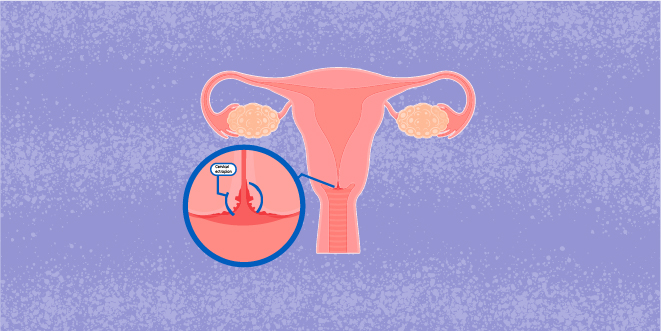Reproductive Health 101: Cervical Ectropion

The female reproductive system is capable of some pretty incredible things like growing humans and bringing them into the world. With so many moving parts, sometimes things can go awry, causing different reproductive health disorders to develop.
When people think of reproductive health disorders it’s usually issues with the ovaries or uterus that come to mind. These aren’t the only female reproductive health organs that can be affected. One important organ that can develop abnormalities is the cervix. This is true in the case of cervical ectropion.
What Is the Cervix?
First, we’ll give you a little refresher on what exactly the cervix is.
Your cervix is a doughnut-shaped organ located between the vagina and the uterus. It helps protect the uterus from infection by blocking out bacteria and plays a crucial role in conception, as well as labor and birth. The cervix is also packed with nerves and can allow for powerful cervical orgasms when stimulated.
The cervix can be affected by different disorders like cervical cancer, polyps, a friable cervix, and today’s topic – cervical ectropion.
What Is Cervical Ectropion?
Cervical ectropion (pronounced ek-tro-pee-un) is sometimes called cervical ectopy or cervical erosion, although that’s not exactly accurate. This condition is caused when the cervix turns inside out (everts), causing the cells that cover the inner area of the cervix to be visible to the outside.
These red cells are called glandular cells. Because of their color, it can cause the affected area to appear red and raw.
Although this sounds scary, cervical ectropion is fairly common affecting anywhere from 17% to 50% of people with cervixes. Not only that, but it’s typically a harmless condition.
What Causes Cervical Ectropion?
Some people are born with cervical ectropion or develop it as an adolescent or adult, although it’s not something to be concerned about. It is most common in people of reproductive age and is rare among postmenopausal people. This is because it’s influenced by high levels of estrogen in the body, which is more common in people who still have a menstrual cycle.
Estrogen levels are also higher during adolescence (hello puberty!), pregnancy, and during ovulation. This means that the risk of cervical ectropion also tends to be higher during these times. Estrogen levels are also higher for people taking hormonal birth control with estrogen in it, another potential risk factor. Cervical ectropion can also be caused by trauma to the area from friction during penetrative sex and infection.
Symptoms of Cervical Ectropion
Many people don’t experience any symptoms of cervical ectropion, instead, your gynecologist may notice signs of it during a pap smear or pelvic exam.
Possible symptoms of cervical ectropion include:
- Vaginal discharge or mucus.
- Increased amounts of vaginal discharge without an infection.
- Light spotting between periods.
- Pain in the back or pelvis.
- Red and raw-looking cervix.
- Pain or bleeding during penetrative sex or a pelvic exam.
Although these could be symptoms of cervical ectropion, it’s more likely that they’re due to other conditions.
Cervical Ectropion Treatment
Cervical ectropion is a relatively harmless condition, and your healthcare provider may not even tell you if they notice signs of it. Most cases of cervical ectropion don’t require treatment and resolve on their own within 3-6 months.
If you’re experiencing uncomfortable symptoms like spotting or frequent discharge your provider may recommend boric acid suppositories. People who are on hormonal birth control with combined hormones (estrogen and progestin) may want to switch to a different contraception that doesn’t contribute to cervical ectropion.
Although it’s not common, some cases can benefit from procedures that destroy cells including:
- Diathermy: Uses high heat on cervical cells that are out of place.
- Silver Nitrate: Uses a chemical stick to burn the ectropion.
- Cryotherapy: Uses extreme cold to freeze cells.
Some people may experience mild vaginal bleeding or discharge, along with period-like pain after receiving treatment for cervical ectropion. These treatments are not recommended during pregnancy and don’t always totally resolve symptoms.
Be sure to tell your provider if you have any abnormal symptoms after treatment including fever, severe abdominal pain, smelly discharge, or heavy vaginal bleeding.
Although cervical ectropion is typically harmless on its own, it’s important to rule out other possible conditions. In some cases, your provider might want to perform a biopsy to check for any cellular abnormalities or a colposcopy, which involves using a lighted instrument to take a closer look at your cervix.
If you have symptoms of cervical ectropion while pregnant your provider will want to examine you to make sure that there isn’t another cause behind any spotting or bleeding.
Cervical Ectropion: What To Remember
Remember that cervical ectropion isn’t a disease, and typically doesn’t require any treatment. Many people don’t even realize that they have it, and often won’t experience symptoms.
There are treatments available for people who are experiencing uncomfortable symptoms. The biggest concern with cervical ectropion is other possible cervical and reproductive health disorders.
It’s important to be proactive about your reproductive health, especially when it comes to your cervix. One of the top ways you can do this is by remembering to get a routine pap smear to check for any cervical cell abnormalities, HPV, or signs of cervical cancer.
If you are concerned about symptoms related to cervical ectropion you’ll want to talk to your gynecologist or healthcare provider with the tools to know how to advocate for yourself.

Natasha (she/her) is a full-spectrum doula and health+wellness copywriter. Her work focuses on deconstructing the shame, stigma, and barriers people carry around birth, sex, health, and beyond, to help people navigate through their lives with more education and empowerment. You can connect with Natasha on IG @natasha.s.weiss.


